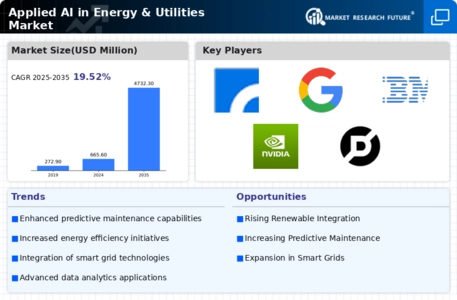Top Industry Leaders in the Applied AI in Energy & Utilities Market

The Competitive Landscape of Applied AI in Energy & Utilities:
The energy and utilities landscape is undergoing a profound transformation, driven by the integration of artificial intelligence (AI). This burgeoning market for applied AI solutions promises to revolutionize power generation, distribution, and consumption, presenting both challenges and opportunities for established players and new entrants alike.
Key Players:
- AAIC
- AltaML Inc.
- ATOS SE
- CEZ Group
- IBM
- Microsoft Corporation
- MindTitan
- Nvidia
- SmatCloud Inc.
- Utility Dive
Strategies Adopted:
- Technological Innovation: Continuous R&D investments are crucial to stay ahead of the curve. Players are focusing on advanced algorithms, machine learning models, and sensor integration to deliver predictive maintenance, optimized grid operations, and personalized energy management.
- Partnerships and Collaborations: Strategic alliances with utilities, infrastructure providers, and research institutions are key to understanding specific needs and accelerating market adoption. This fosters broader ecosystems and facilitates data sharing for more robust AI solutions.
- Focus on Specific Segments: Companies are specializing in niche areas like renewable energy forecasting, distributed energy resource management, and smart meter analytics to cater to distinct customer demands and achieve market differentiation.
- Scalability and Customization: Adaptable AI solutions tailored to diverse utility infrastructures and operational nuances are essential for wider market penetration. Cloud-based deployment models and flexible subscription options further enhance accessibility.
Market Share Analysis:
- Technology Leadership: Advanced AI capabilities, proven success stories, and robust data security protocols are critical factors for establishing market dominance.
- Customer Experience: Providing seamless integration, ongoing support, and measurable ROI through AI solutions builds trust and loyalty among utility companies.
- Pricing Strategies: Cost-effective solutions targeting budget-conscious utilities can capture a larger market share, while premium offerings with cutting-edge features cater to those prioritizing top-tier performance.
- Regional Focus: Understanding geographical nuances, regulatory environments, and energy landscapes in different markets is crucial for tailoring solutions and achieving regional success.
New and Emerging Companies:
- Blockchain-Enabled AI: Start-ups like Grid++ and Energy Web Foundation are harnessing blockchain technology to enhance data security, transparency, and traceability in AI-powered energy systems.
- Edge Computing: Companies like Exelon and Sentient are leveraging edge computing at the grid edge to enable faster decision-making and real-time optimization of energy operations.
- AI-powered Robotics: Robotics companies like Flybotics and SkySpecs are integrating AI for automated inspection and maintenance of critical energy infrastructure, improving efficiency and safety.
Current Investment Trends:
- Renewable Energy Integration: AI solutions for forecasting, grid stabilization, and optimal dispatch of renewables are attracting significant investments due to the global push towards clean energy.
- Predictive Maintenance: Early detection and prevention of equipment failures through AI-powered analytics is gaining traction as utilities seek to minimize downtime and optimize asset management.
- Demand-Side Management: AI-driven demand forecasting and dynamic pricing models are enabling utilities to better manage peak loads and incentivize energy efficiency among consumers.
Latest Company Updates:
12th January 2024, Tesla announces plans to integrate AI into its Powerwalls to optimize energy storage and grid flexibility. The new feature will use AI to predict energy demand and adjust battery charging and discharging accordingly, helping to smooth out fluctuations from renewable energy sources.
5th January 2024, DeepMind AI partners with EDF Renewables to improve wind farm forecasting accuracy. The collaboration aims to develop AI models that can predict wind power generation with greater precision, allowing for better grid integration and reduced reliance on fossil fuels.

